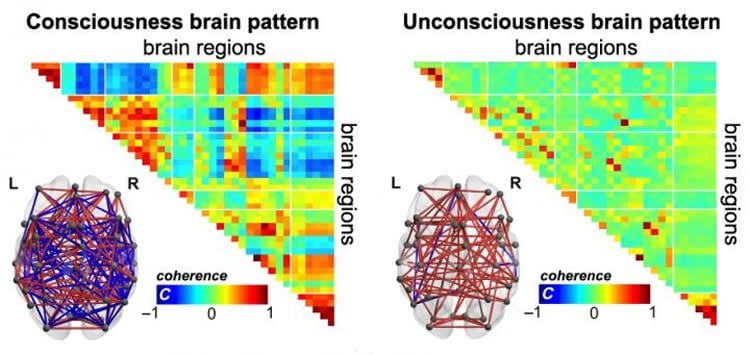Summary: Researchers say human consciousness is supported by dynamic, complex patterns of brain signal coordination.
Source: AAAS.
Amid longstanding difficulties distinguishing consciousness in humans in unconscious states, scientists report fMRI-based evidence of distinct patterns of brain activity they say can differentiate between consciousness or unconsciousness. Detecting these patterns in real-time could allow for externally induced manipulations that noninvasively restore consciousness.
The detection process also has the potential to greatly facilitate medical decision-making for patients in whom consciousness is impaired, the authors say.
Unconsciousness is characterized by an inability to report subjective experience. For patients induced into temporary unconsciousness via pharmacological agents such as anesthetics, or for those in a more enduring state of unconsciousness caused by brain injury, reliable markers indicating presence or absence of consciousness have been elusive.
In search of such indicators, A. Demertzi and colleagues recorded functional magnetic resonance imaging (fMRI) data from 159 subjects scanned at four independent research sites. Some among these were healthy patients who had undergone anesthesia.
The others, assessed through standardized behavioral assessments, were patients diagnosed as having either unresponsive wakefulness syndrome (UWS) – in which they can open their eyes but do not display voluntary movements – or as being in a minimally conscious state (MCS) – in which they show additional behaviors potentially indicative of awareness.
The authors analyzed how fluctuations of the fMRI blood oxygenation level-dependent (BOLD) signal – a proxy for neuronal activity – were coordinated across 42 key brain regions representing six brain networks known to play an important role in cognition. The analysis uncovered four distinguishable patterns: pattern 1 was highly complex, with long-distance brain-wide coordination between regions. It was seen more often in healthy, conscious people. Pattern 4, on the other hand, showed low interareal coordination and was most apparent in UWS patients.

Demertzi and colleagues found that anesthetized patients displayed a lower probability or transitioning between different brain states over time. These findings provide insight into the large-scale brain dynamics that support conscious behavior – suggesting that highly complex, long-distance brain-wide coordination is a key characteristic of consciousness – and they offer important clues in the search for biological markers of consciousness, say the authors.
Source: AAAS
Publisher: Organized by NeuroscienceNews.com.
Image Source: NeuroscienceNews.com image is credited to E. Tagliazucchi & A. Demertzi.
Original Research: Open access research for “Human consciousness is supported by dynamic complex patterns of brain signal coordination” by A. Demertzi, E. Tagliazucchi, S. Dehaene, G. Deco, P. Barttfeld, F. Raimondo, C. Martial1, D. Fernández-Espejo, B. Rohaut, H. U. Voss, N. D. Schiff, A. M. Owen, S. Laureys, L. Naccache and J. D. Sitt in Science Advances. Published February 1 2019.
doi:10.1126/sciadv.aat7603
[cbtabs][cbtab title=”MLA”]AAAS”Brain Patterns Indicative of Consciousness, in Unconscious Individuals.” NeuroscienceNews. NeuroscienceNews, 6 February 2019.
<https://neurosciencenews.com/consciousness-brain-patterns-10698/>.[/cbtab][cbtab title=”APA”]AAAS(2019, February 6). Brain Patterns Indicative of Consciousness, in Unconscious Individuals. NeuroscienceNews. Retrieved February 6, 2019 from https://neurosciencenews.com/consciousness-brain-patterns-10698/[/cbtab][cbtab title=”Chicago”]AAAS”Brain Patterns Indicative of Consciousness, in Unconscious Individuals.” https://neurosciencenews.com/consciousness-brain-patterns-10698/ (accessed February 6, 2019).[/cbtab][/cbtabs]
Abstract
Human consciousness is supported by dynamic complex patterns of brain signal coordination
Adopting the framework of brain dynamics as a cornerstone of human consciousness, we determined whether dynamic signal coordination provides specific and generalizable patterns pertaining to conscious and unconscious states after brain damage. A dynamic pattern of coordinated and anticoordinated functional magnetic resonance imaging signals characterized healthy individuals and minimally conscious patients. The brains of unresponsive patients showed primarily a pattern of low interareal phase coherence mainly mediated by structural connectivity, and had smaller chances to transition between patterns. The complex pattern was further corroborated in patients with covert cognition, who could perform neuroimaging mental imagery tasks, validating this pattern’s implication in consciousness. Anesthesia increased the probability of the less complex pattern to equal levels, validating its implication in unconsciousness. Our results establish that consciousness rests on the brain’s ability to sustain rich brain dynamics and pave the way for determining specific and generalizable fingerprints of conscious and unconscious states.






